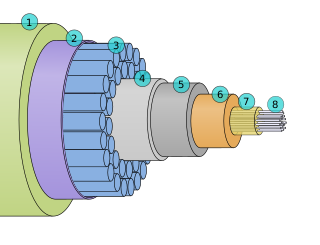This article is about Communications in Papua New Guinea including newspapers, radio, television, and the Internet.

A submarine communications cable is a cable laid on the sea bed between land-based stations to carry telecommunication signals across stretches of ocean and sea. The first submarine communications cables laid beginning in the 1850s carried telegraphy traffic, establishing the first instant telecommunications links between continents, such as the first transatlantic telegraph cable which became operational on 16 August 1858. Subsequent generations of cables carried telephone traffic, then data communications traffic. Modern cables use optical fiber technology to carry digital data, which includes telephone, Internet and private data traffic.

Port Moresby, also referred to as Pom City or simply Moresby, is the capital and largest city of Papua New Guinea and the largest city in the South Pacific outside of Australia and New Zealand. It is located on the shores of the Gulf of Papua, on the south-western coast of the Papuan Peninsula of the island of New Guinea. The city emerged as a trade centre in the second half of the 19th century. During World War II it was a prime objective for conquest by the Imperial Japanese forces during 1942–43 as a staging point and air base to cut off Australia from Southeast Asia and the Americas.
PIPE Networks is an Australian telecommunications company, based in Brisbane, Queensland. It is a subsidiary of TPG Telecom. It is primary business is setting up peering exchanges. PIPE itself stands for "Public Internet Peering Exchange". The company also provides services such as co-location, telehousing, and fibre networks.

The Territory of Papua comprised the southeastern quarter of the island of New Guinea from 1883 to 1975. In 1883, the Government of Queensland annexed this territory for the British Empire. The United Kingdom Government refused to ratify the annexation but in 1884 a Protectorate was proclaimed over the territory, then called "British New Guinea". There is a certain ambiguity about the exact date on which the entire territory was annexed by the British. The Papua Act 1905 recites that this happened "on or about" 4 September 1888. On 18 March 1902, the Territory was placed under the authority of the Commonwealth of Australia. Resolutions of acceptance were passed by the Commonwealth Parliament, who accepted the territory under the name of Papua.

Air Niugini Limited is the national airline of Papua New Guinea, based in Air Niugini House on the property of Jacksons International Airport, Port Moresby. It operates a domestic network from Port Moresby to all 12 major airports while the subsidiary company Link PNG operates the minor airports. It also operates international services in Asia, Oceania, and Australia on a weekly basis. Its main base is Jacksons International Airport which is located in 7 Mile, Port Moresby, Papua New Guinea. Niugini is the Tok Pisin word for New Guinea.
AWA may be an abbreviation for:
Asia Pacific Airline is an airline based in Tabubil, Papua New Guinea. It is a subsidiary of National Jet Systems. It operates domestic services, as well as flights to Cairns, Australia. Its main base is Tabubil Airport.
PNG Air is an airline based on the grounds of Jacksons International Airport, Port Moresby, Papua New Guinea. It operates scheduled domestic and international flights, as well as contract corporate charter work. Its main base is Jacksons International Airport.
SEA-ME-WE3 or South-East Asia - Middle East - Western Europe 3 is an optical submarine telecommunications cable linking those regions and is the longest in the world. Completed in late 2000, it is led by France Telecom and China Telecom, and is administered by Singtel, a telecommunications operator owned by the Government of Singapore. The Consortium is formed by 92 other investors from the telecom industry. It was commissioned in March 2000.

A cable landing point is the location where a submarine or other underwater cable makes landfall. The term is most often used for the landfall points of submarine telecommunications cables and submarine power cables. The landing will either be direct or via a branch from a main cable using a submarine branching unit. The branch can be many kilometres long.
The APNG-2 submarine communications cable was construct to link Papua New Guinea directly to Australia and indirectly to New Zealand and the rest of the world, and has been in service from late 2006.
PacRimWest was a twin-pair 560Mbit/s optical submarine telecommunications cable which served as Australia's main link to the world along with its partner cables Tasman2 and PacRimEast.
Transport in Oceania is most advanced in Australia, Hawaii and New Zealand, though all countries in the region have faced difficulties in providing facilities due to their low population density. Smaller islands are dependent on sea and air transport, but have had difficulties operating either national or regional airlines and shipping lines.
PIPE Pacific Cable (PPC-1) is a 6,900 km submarine cable laid by PIPE Networks. It runs from Cromer, New South Wales, in Australia, to Piti, Guam.
Europe India Gateway (EIG) is a submarine communications cable system to connect the U.K., Portugal, Gibraltar, Monaco, France, Libya, Egypt, Saudi Arabia, Djibouti, Oman, United Arab Emirates, and India.
COMPAC, the Commonwealth Pacific Cable System, was an undersea telephone cable system connecting Canada with New Zealand and Australia. It was completed by closing the last gap in Honolulu Harbor, Hawaii, at 6:25 a.m. B.S.T. on October 10, 1963. Public service of the cable commenced early in December 1963.




